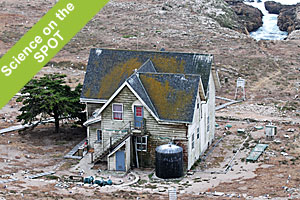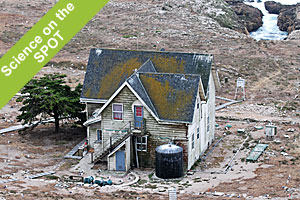 The scientists on the Farallones live in the old lighthouse keepers’ houses, built in the late 1800’s.The Farallon Islands off the coast of California are a vital home to many birds and marine mammals. In fact, the islands boast the largest sea bird breeding colony in the contiguous United States and have one of the largest fur seal populations south of Alaska. They are hard to get to and once you are there, you may wonder why on earth you ever decided to come to these windswept, desert islands. “After you’ve been on the island for a while,” says PRBO Program Manager Russ Bradley, “it starts to sound like the gulls are saying your name.”
The scientists on the Farallones live in the old lighthouse keepers’ houses, built in the late 1800’s.The Farallon Islands off the coast of California are a vital home to many birds and marine mammals. In fact, the islands boast the largest sea bird breeding colony in the contiguous United States and have one of the largest fur seal populations south of Alaska. They are hard to get to and once you are there, you may wonder why on earth you ever decided to come to these windswept, desert islands. “After you’ve been on the island for a while,” says PRBO Program Manager Russ Bradley, “it starts to sound like the gulls are saying your name.”
The chill of the fog and wind cut through you, the kelp flies swarm, the overpoweringly acrid smell of years-worth of bird guano wafts through the air and loud, incessant cackle of hundreds, even thousands of sea gulls, could drive even the hardiest of souls away from this desolate outcropping of granite in the middle of the Pacific Ocean. The animals wouldn’t want it any other way. And neither would the researchers and biologists stationed at the Farallones.
While only 27 miles off the coast of San Francisco, for the human inhabitants, life can also seem isolated and lonely. They have a very small neighborhood. Only two houses still stand on Southeast Farallon. Today the old lighthouse keepers’ houses, originally built in the late 1800’s, house the small team of researchers from PRBO Conservation Science. A bit of Victorian civilization in an otherwise completely wild world.
It is a rare privilege to be able to set foot on the Farallon Islands. As rugged as this place may seem, it is a fragile and extremely sensitive environment. As a National Wildlife Refuge, the area is strictly off limits to the public. Each year only a few dozen people are allowed to be hoisted onto South Farallon Island, and most, if not all, are there specifically to conduct scientific research. The humans there now tread lightly. QUEST was invited out to the islands to get an inside look at this living laboratory and meet some of the people doing important scientific research on such wide ranging topics as global climate change to highly specific studies on sea bird breeding rates.
